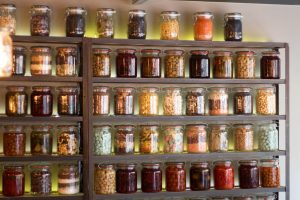Every year at Thanksgiving my mom shoos all of us out of the kitchen so she can cook undisturbed. As the person who cooks the majority of the time in my own house, I understand the desire to work in peace. But my mom’s insistence on cooking alone means we don’t get to spend much time with her during the day. While she’s holed up in the kitchen, the rest of us get to play board games, watch football, and socialize. My mom misses out on a lot of family time and when the food is ready, she’s exhausted.

We put a lot of pressure on holiday meals, the food needs to taste amazing, it all needs to be hot and ready at the same time, and it needs to please everyone at the table.
Or so we think.
Holiday meals differ from other weeknight meals in only two ways, 1) we make food traditional to our family and that holiday and 2) perhaps we have additional people to feed that we only see a few times a year.
There is a third difference between a weeknight dinner and a holiday meal – we put a lot of pressure on ourselves to do everything just right. There’s a lot of emphasis on how the food tastes and if everyone’s favorite dish is present, but really the important part is getting to share that time with the people we care about. Especially if we’re hosting guests we don’t see very often.
Food is important for its nourishment and enjoyment, but it also provides a reason to sit down with our community and connect. And in that regard, what you’re eating isn’t nearly as important as who you’re sharing it with.
Try these three tips to take some of the stress off the food prep and cooking, so you can focus on the community and connection you get from holiday meals instead of worrying about everything being just right.

1) Get your meal planning done early
The best way to add ease to your holiday meal is to have a plan made well before the food is prepared. If your family eats the same traditional food for a holiday meal, there’s no reason your meal plan can’t be made up to two weeks ahead of time.
In Plan to Eat, you can navigate back to last year’s holiday meal and either duplicate that meal plan or save it as a Menu to reuse as many times as you want. Rather than keeping track of recipes and ingredients on a scrap piece of paper, have your meal plan set in your Plan to Eat calendar and let the program make a comprehensive shopping list for you.
2) Ask for help
It’s not always easy to share the kitchen when you have your own way of prepping and cooking, but allowing others to help removes the burden of preparing all the food by yourself. Plus, sharing the cooking experience with others is a great way to connect. You can share your techniques and knowledge with other members of your family and not miss out on quality time spent together.
You can also make your holiday meal more of a potluck and ask others to bring their favorite dish. You won’t have to cook everything on the table and your guests will feel included in the meal.
If you’re concerned about the meal being unbalanced, assign guests a dish to bring and then add a note on your Planner to remind yourself who’s bringing what.
3) Prep meals for the days leading up to the holiday
So much time is spent thinking about the holiday meal, but everyone needs to eat the rest of the week too! Batch cook and freeze a few recipes ahead of time, like a casserole or soup, to take the load off cooking the other days of the week.
In Plan to Eat, you can batch-cook recipes and keep track of them with the Freezer, so you have an inventory of what meals you can thaw and serve.
Rather than put unnecessary pressure on yourself to have the “perfect” meal, do some planning, ask for help, and let the meal be a means to engage with your family and friends.






